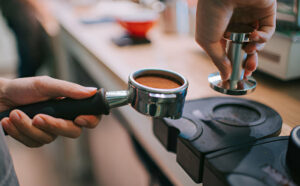-
Empty cart
No products in the cart.
Return to Shop

10 Must-Have Essentials for Perfect Espresso Coffee
Brewing the perfect espresso at home starts with having the right tools. Each piece of equipment plays a vital role in crafting a rich, flavorful

Have you ever thought about the relationship between freshness and flavor? We pursue freshness because we want our coffee to taste good, right? After all, nobody drinks coffee for the CO2! So, it seems we’re back to the old question: How long should beans be aged? Will coffee that’s been stored for a long time still taste good?
not be easy to answer, but as the saying goes, it depends on the beans, how you handle them, and how you brew. It’s not just idle talk, it’s the truth. However, today’s notes from Samo Smrke on Instagram might provide you with some new perspectives and frameworks to consider the freshness versus sensory experience debate.
Let’s delve into it, happy brewing!
(Using the 9-point hedonic scale, with 1 being extremely disliked and 9 being extremely liked)
The 9-point hedonic scale is familiar to many, with 5 representing neutrality. The graph below illustrates Samo Smrke’s subjective espresso flavor evaluation scores👇 (You can also rate the flavor of a bean on different days based on your own sensory experience!)
(X-axis: Days after roasting, Y-axis: Sensory rating)
Test beans reach peak freshness between 14 and 30 days after roasting.
👉 This may be because during the peak freshness stage, after a period of stable extraction, certain aroma changes continue to enhance the quality of coffee flavor.
(This might explain why some beans seem to taste better the longer they are stored.)
Solution: In such cases, extraction needs to be optimized according to freshness changes to maintain high-quality espresso output.
Degassing refers to the release of carbon dioxide from coffee during storage. Here, Samo uses the gravimetric method developed by the Coffee Excellence Center.
(X-axis: Days after roasting, Y-axis: Specific degassing quality, Unit: mg/g)
The graph above shows the mass of carbon dioxide released per gram of coffee beans after roasting (mg). The curve follows a diffusion equation model, indicating a close fit to the data, despite some noise. Data approaches 7mg from day 56 onwards.
As coffee ages, changes in aroma composition lead to flavor alterations. Even when stored in coffee bags, volatile compounds escape through one-way valves along with carbon dioxide, gradually diminishing due to oxidation. In other words, as oxygen decreases inside the bag, aroma loss weakens. (Assuming the bag’s seal and one-way valve are effective!)
· 2,3-Butanedione, aka Diacetyl
· Propanol
· Methylpyrazine
The table above shows the changes in four volatile compounds over time since roasting (coffee bean status).
Methanethiol is an unstable substance found in ripe coffee beans, and its reduction rate is extremely fast. It has an unpleasant odor. Therefore, Samo suspects that this may also be one of the reasons why many freshly roasted coffee beans don’t taste good.
“Technical freshness peak” is likely associated with the carbon dioxide content in coffee and the degassing process.
Sensory peak freshness typically occurs later than technical freshness peak, altering coffee extraction properties. Extraction optimization needs to be within the sensory peak range, whereas the latter (technical freshness peak) has passed.
👉 Understand that degassing and aroma loss are two phenomena that occur simultaneously but progress differently.
👉 Sensory quality mostly depends on aroma quality; carbon dioxide isn’t necessarily needed unless we want a thick crema on top! (Do you agree with this statement?)
· Freshness has been a longstanding issue. Beginners often believe fresher beans are better, and some even judge coffee quality by the richness of “bubbles” (some love an extra-rich crema). If you’ve been troubled by these concerns, perhaps it’s time for some answers?

Brewing the perfect espresso at home starts with having the right tools. Each piece of equipment plays a vital role in crafting a rich, flavorful

Hey there, fellow coffee aficionados! Have you ever witnessed the mesmerizing dance of espresso flowing freely from a bottomless portafilter? If not, prepare to be

If you’ve ever made espresso, you’ve probably heard the tip to press the coffee powder hard with a coffee tamper to ensure a good extraction.

What You Should and Shouldn’t Know About Cold Brew and Caffeine. What is Cold Brew Coffee? You’re probably familiar with cold brew coffee
Copyright 2024 © All rights Reserved. Design by EspressoFree

How can we help you?